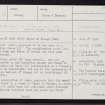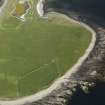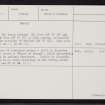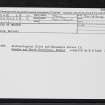Pricing Change
New pricing for orders of material from this site will come into place shortly. Charges for supply of digital images, digitisation on demand, prints and licensing will be altered.
Sanday, Styes Of Brough
Burial(S) (Viking)
Site Name Sanday, Styes Of Brough
Classification Burial(S) (Viking)
Alternative Name(s) Sties Of Brough; Sty Wick
Canmore ID 3509
Site Number HY64SE 18
NGR HY 65464 42082
Datum OSGB36 - NGR
Permalink http://canmore.org.uk/site/3509
- Council Orkney Islands
- Parish Cross And Burness
- Former Region Orkney Islands Area
- Former District Orkney
- Former County Orkney
HY64SE 18 6547 4210
See also HY63NE 10, HY64SE 25 and HY64SE 30.
(Name: HY 6547 4210) Styes of Brough (NAT)
OS 6" map, Orkney, 2nd ed., (1900).
A small knoll, supposed to be the site of a Pictish House (Name Book 1879). The neighbouring names Ness of Brough and Styes of Brough may have some relevance.
A Viking sword 29" long overall, and now preserved in the Hunterian Museum was found in a tumulus at Sties (RCAHMS 1946) (interpreted as a Viking's grave by Wainwright) and was in the possession of Walter Denison of Brough (RCAHMS 1946) or West-Brough (S Grieg 1940) in 1874. The association of names suggests that the sword was found in a mound at Styes of Brough, in which case it could mean the published site; although Dr Marwick believed that the sword was found near the beach between Els Ness (NY 67 38) and Tress Ness (HY 70 38) in Lady parish, presumably in the vicinity of StyWick (HY 68 38).
(See also HY63NE 10 and HY64SE 30).
J Anderson 1875; RCAHMS 1946, visited 1928; F T Wainwright 1962.
An area of disturbed ground c30.0m in diameter still known as 'Styes of Brough' which undoubtedly hides an ancient structure. Unable to classify. There is no local knowledge of the Viking sword (but see HY64SE 30).
Visited by OS (NKB) 6 July 1970.
Note (1980)
Sties of Brough, Sanday HY c. 654 421 HY64SE 18 & 30
RCAHMS and OS record separately one large mound to which they apply the name, and two lesser ones; but the sties in fact are four widely spaced mounds with indications that they were burial-mounds. Probable find spot of several Viking objects (see nos. HY64SE 25, HY64SE 26) and may well be Viking burial-mounds.
RCAHMS 1980
(Name Book, Orkney, No. 2, p. 73; RCAHMS 1946, ii, p. 44, No. 188; OR 324)
Field Visit (1999)
Four mounds, of which three lie within the area under investigation by this survey, were previously identified as probable Viking burials due to chance finds of Viking-period artifacts (HY64SE26) said to have been made in the area. Recent assessment has indicated that the mounds are of prehistoric date, although a disturbed boat-shaped setting was found which may be part of a Viking burial setting. The southernmost mound (HY64SE18) is 30m in diameter. It is prominently located on a natural rise, has a conical shape and lies within 10m of the coast. The surface is pitted and stony. A low grass-covered bank runs off for some 10m from the east side of the mound. A second mound (HY64SW30,'B'), 10m in diameter and lies c.45m to the northeast. The surface is uneven and stony with what may be part of a structural feature. The third mound (HY64SW18, 'A') lies to the north, is oval in shape and measures 13m by 11m. It stands to 1m high and lies 18m from the sea. Ref.: Orkney Name Book, no.2, 73; Grieg, S (1940) 'Viking Antiquities in Great Britain and Ireland: part II' 171-2; RCAHMS (1946), #188; RCAHMS (1980), #132; Hunter, JR & Dockrill, SJ (1982) 'Some Norse Sites on Sanday, PSAS, 112, 570-76; Owen, O & Dalland, M 1999 'Scar: A Viking Boat Burial on Sanday, Orkney', Tuckwell Press/Historic Scotland, 14; Bond, Dockrill, Gibson & Owen forthcoming 'The Styes of Brough, Sanday, Orkney, re-examined for Channel 4's Time Team'.
Coastal Zone Assessment Survey, 1999
Orkney Smr Note
Carins: HY 6541 4213, a robbed cairn, survivies as a rim of
cairn material 14m diameter, 0.3m high, slab on edge in SE arc.
HY 6546 4216, prominently sited on a rise, survives as a
disturbed turf-covered mound 10m diameter, 0.3m high. Possibly
source of Viking sword. OS index HY 64 SE 30, OS visit Jul 70.
Ordnance Survey takes the name Styes of Brough to refer
only to HY 6547 4210 but it is not clear why this is so, as this
is one of a group of four mounds to which the name very likely
refers collectively. HY 6547 4210 is as described, very
irregular and probably heavily disturbed. In HY 6541 4213, the
edge-slab mentioned by OS is set radially to centre of mound and
is 2m in from the edge of the mound - quite a distinct edge - so
it is probably part of some internal structure. A circular
stone-lined hollow in the centre of HY 6546 4216 is probably a
kelp-burning pit. There is another cairn at HY 6540 4216, very
much reduced but surviving as a just perceptible rise with
several earthfast stones showing. The four mounds form an
approximate square. Vestiges of old field boundaries occur all
over Ness of Brough but none appears definitely associated with
these mounds. RGL Aug 79, inf Mr Towrie, Westbrough.
A Viking sword, a Viking axe and a Viking cauldron all
may have come from this site, Sties being given as the location
for the sword and cauldron, Brough for the axe, but the
provenances are not absolutely certain. The general appearance
of the mounds, the fact that they obviously have been dug into,
and their location on the property of Brough through the hands of
whose proprietor, W Dennison, the sword is known to have passed,
all support this provenance.
Information from Orkney SMR (RGL), OR 325, 326, 327.














